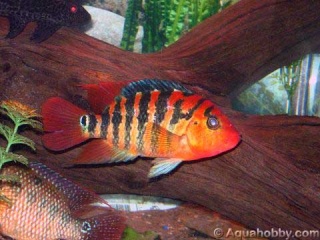ExCichlasoma (Amphilophus) featae AKA Red Terror Cichlid
Scientific Name(s): ExCichlasoma (Amphilophus) featae
Common Name(s): Red Terror Cichlid
Origin: South America regions of Columbia, Ecuador, and Peru.
Family: Cichlasoma
Species Type: South American Cichlid
Maximum Size: Males commonly reach 15-16 inches and females tend to stay smaller at about 12 inches.
Life Span: 10 plus years
Natural Habitat: South American rivers (Ecuador and Columbia)
Diet: Omnivore, in the wild they will eat insects, shrimps, small fish and plant matter. In the aquarium they can be fed pellets or sticks. A good quality pellet staple is recommended and varied with different types of frozen, freeze dried and live foods.
Temperature: 74-82 degrees
PH: 6.5 - 7.5
Minimum Tank Size: I would recommend a 75g for a single fish. 125g MINIMUM for a tank with tank mates and 180g for a breeding pair.
Tank Region: Mainly bottom but you will see this cichlid explore all levels of the tank.
Temperament: Highly Aggressive (highly Territorial)
Possible Tank Mates: Larger Central or South American Cichlids with similar temperament and size. Remember a large tank will be necessary if you are planning tank mates.
Filtration and Setup: Heavy filtration is necessary as this species, as with most large Cichlids, produce a lot of waste and are very messy eaters. I would recommend a water turnover of at least 10x per hour. I would also recommend a filter capable of providing a lot of biological as well as mechanical filtration. Water changes are also necessary in large amounts, 50% weekly being a good starting point.
The festae is a digger and will uproot plants...lots of slate; large rocks, caves and driftwood make good decor choices. Fake plants can be used but like live plants will likely be up rooted. I would recommend a gravel substrate mainly because of their digging habits.
Coloration: The festae has beautiful coloration in my opinion. Female have a reddish base with blue vertical stripes, and have greenish yellow hues on the lower half of the body. Males have more of a golden base with spots on the body; males also have blue vertical stripes with spangling of blue throughout the body and fins.
Sexing: Besides their color, males are larger and at a juvi stage will grow faster. The males dorsal and anal fins are also longer and more pointed and the males will develop a nuchal hump.
Breeding: Breeding the festae is very hard because of their aggressive nature and size. The festae gets very territorial when breeding, beware if there are tank mates present it will not be a good situation. The festae breeds in typical South American Cichlid fashion. The female will dig a pit or find a piece of slate to lay the eggs. The male will then come along and fertilize the eggs. The female festae will lay close to 1000 eggs and you can plan to have at least 500 fry...The festae are good parents and fry can be fed crushed flake and ground up live and freeze dried foods high in protein.
Notes: When purchasing a feaste make sure you are getting a "true" Red Terror and not a "false" Red Terror. You want to purchase an ExCichlasoma (amphilophus) festae and not an ExCichlasoma (Nandopsis) urophthalmus. The urophthalmus is the most commonly sold species commercially and is not as colorful and does not get as big. If you want a truly colorful and true Red Terror research and know what you are buying.
Male

Female

Photos courtesy: Aquahobby.com







